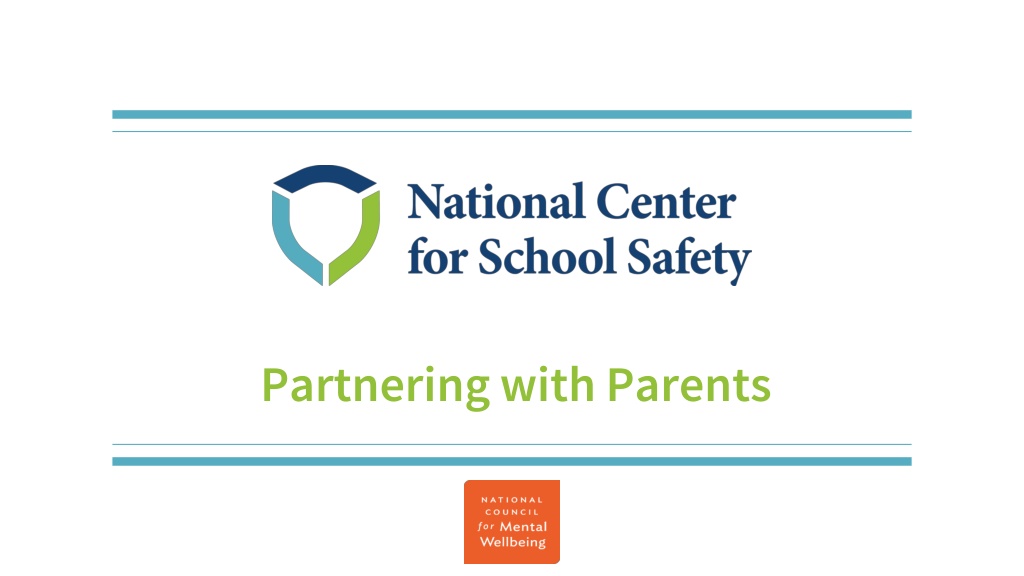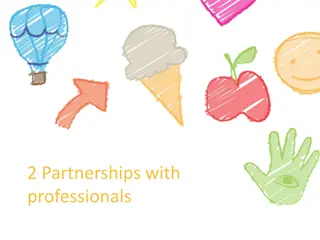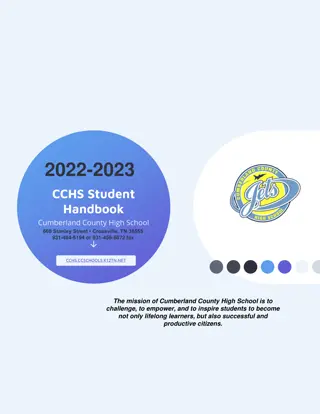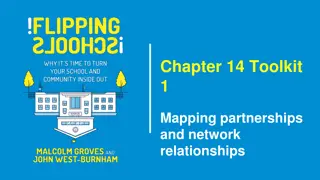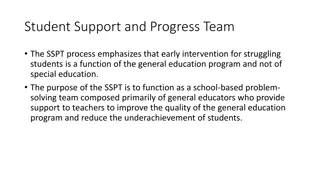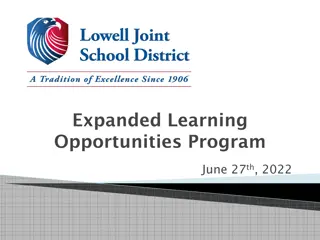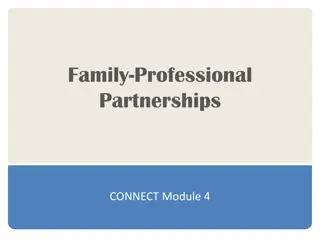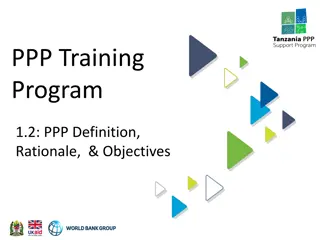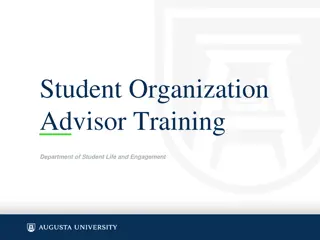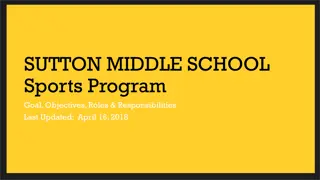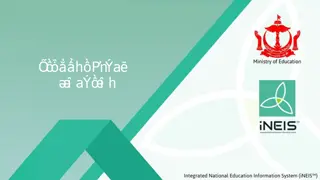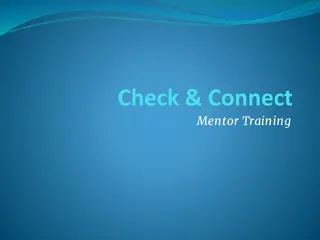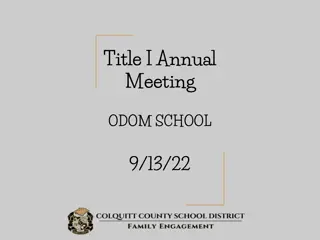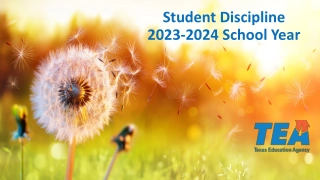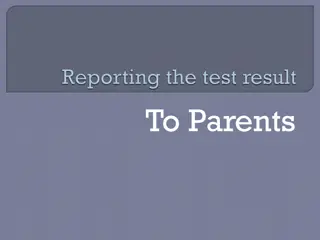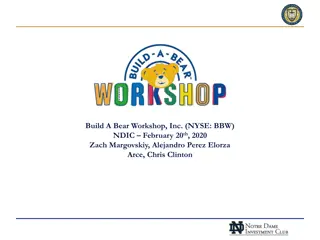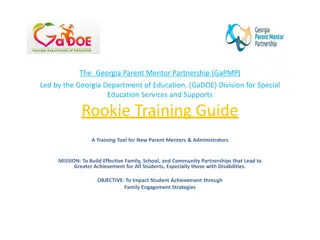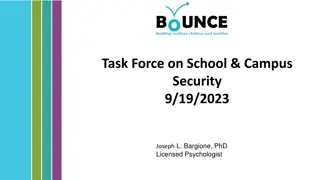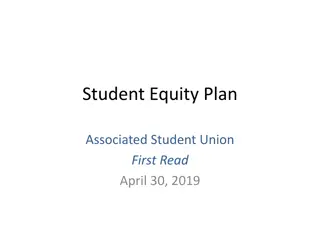Building Strong School-Home Partnerships for Student Success
Prioritizing parental engagement over involvement is key to creating effective school-home partnerships. By shifting towards a model of parental engagement, schools can better serve families, listen to their needs, and work together towards shared goals. Welcoming diverse families, building relationships, and sharing decision-making are crucial components of effective parent and family engagement in education.
Download Presentation

Please find below an Image/Link to download the presentation.
The content on the website is provided AS IS for your information and personal use only. It may not be sold, licensed, or shared on other websites without obtaining consent from the author. Download presentation by click this link. If you encounter any issues during the download, it is possible that the publisher has removed the file from their server.
E N D
Presentation Transcript
Family Collaboration Student- Centered Planning School Teams Community Collaboratio n Family Partnerships
Why Partner with Parents/Guardians and Families? Classrooms that prioritize parent involvement see a rise in performance for all students, not just the children of involved parents. When teachers work to engage with parents, student absences drop by 20%. As educators' partner with and empower families, children will be able to reach their full potential. Molnar, M. (2012, April 3) Involving Parents in Partnerships to Boost Student Outcomes. Education Week. Retrieved February 8, 2021 https://www.edweek.org/education/involving-parents-in-partnerships-to-boost-student-outcomes/2012/04. Chen, G. (2020, October 10). Parental Involvement is Key to Success. Public School Review. https://www.publicschoolreview.com/blog/parental- involvement-is-key-to-student-success.
Shifting Parental Involvement to Parental Engagement Involvement to enfold doing to parents Engagement to come together doing with parents Goal: To serve parents Goal: To gain partners Identify projects, needs and goals, then tells parents how they can contribute. Listening to parents think, dream and worry. School leads with its mouth Schools lead with their ears Ferlazzo, Larry. (2011, May). Involvement or Engagement? Educational Leadership, 68(8): 10-14. Retrieved February 8, 2021 from http://www.ascd.org/publications/educational-leadership/may11/vol68/num08/Involvement-or-Engagement%C2%A2.aspx.
Parent and Family Engagement Looks Like Building relationships Listening to parents & family Welcoming families into the school Sharing decision-making with parents
Each students family is unique Pew Research Center. (2015). The American family today. Parenting in America: Outlook, worries, aspirations are strongly linked to financial situation. Retrieved February 8, 2021 from https://www.pewsocialtrends.org/2015/12/17/1-the-american-family-today/
Welcoming Diverse Students, Parents, and Families Reflect on our own personal identity Influence on our interpretation of diversity Influence our approach to communication Influence how the classroom reflects diverse cultures Be curious about each family s culture and preferences Their perspective on school Approach to communication Factors of environmental comfort
Inclusive Engagement Are you reaching and hearing from families representing all segments of the school population? Across all races, cultures, and languages Parents and families with unstable housing Every socio-economic group Parents of students, pre-K through graduation Parents of student in enrichment programs and special education programs Parents distanced from their students. Parents in non-traditional family constellations
Trauma Impacts Trust in Relationships Build connection & relationships with families
Gathering Input From Staff Share the reason for seeking input Gain input on how to increase engagement Brainstorm ways to decrease barriers to parent and family engagement
Share Information in Many Ways www.TheNationalCouncil.org
November message from Dr. A www.TheNationalCouncil.org Try a Video Message! KTEC. (2020). November message from Dr. A. Retrieved February 8, 2021 from https://youtu.be/uTqGqG7yHqg .
Gathering Critical Information High priority placed on seeking family perception of: Safety Trustworthiness Collaboration Student Voice and Empowerment Peer Support Diversity and Engagement Done through: Surveys / Focus Groups Interviews Home Visits
Formal Feedback and Follow Up Formal system in place to: Continuously gather family feedback Identify problem areas Make changes as needed
National Parent Teacher Association Family Engagement Standards www.TheNationalCouncil.org 1. Welcoming all families into the school community 2. Communicating effectively 3. Supporting student success 4. Speaking up for every child 5. Sharing power 6. Collaborating with community National PTA. (n.d.). Successful Family-School Partnerships. National Standards for Family-School Partnerships. Retrieved February 8, 2021 from https://www.pta.org/home/run-your-pta/National-Standards-for-Family-School-Partnerships.
Connecting with Parents and Families Welcoming new students & their families as part of the school family Giving parents and families a voice Finding a connection Allow for two-way feedback
Finding a Niche for all Parents and Families Volunteering In the classroom Anywhere in the school Sharing and teaching their craft Participating on committees Learning English About trauma New academic skills Their rights and advocacy skills
Providing Learning Opportunities for Parents English language classes Parenting classes Computer skills Trauma and trauma-informed resilience-oriented schools Self-care and compassion resilience
https://youtu.be/ubo6L0qQv6Q LSNA Chicago. (2012). Education Nation: Putting Parents to Work in the Classroom. NBC Today Show. Retrieved February 8, 2021 from https://youtu.be/ubo6L0qQv6Q.
Steps Toward Shared Decision-Making Work together to break down barriers Jointly create schoolwide procedures and policies Included on school/district academic standards committees Family learning events Database of parent and family skills, expertise, and backgrounds Joint planning on conflict resolution. PTA National Standards Assessments
What are the barriers to engagement in families lives?
Authenticity Tokenism: Perfunctory effort or symbolic inclusion of a group or, a substitute for the real thing. Looks like: Just for looks seen, counted, but not heard Hearing their words, not taking them into consideration Not paying for expert advice expecting the person to volunteer Expecting the status quo expecting the person to say yes, remain passive, and not to speak their truth.
Use resource mapping to ensure capacity to increase engagement of parents
Apply the Trauma-Informed, Resilience-Oriented Principles to Address Concerns Safety Trustworthiness Collaboration Student voice and Empowerment Peer Support Diversity and Engagement
Using the principles to increase authentic parent communication all areas? Move around barriers by Listening to understand and not to reply Speaking with empathy Providing transportation Meeting in a neutral place Teaching skills emotional regulation, behavioral skills Preparing parents for meetings Never using coercion to seek compliance
Trauma-informed, Resilience-Oriented Schools Relationship Policy Our school is invested in supporting the very best possible relational health between Parents and children Child and child Child and school staff Parent and school staff School staff School staff and senior leaders School staff and external agencies To this end our school is committed to educational practices which Protect, Relate, Regulate, and Reflect. Trevithick Learning Academy. (2018). Trevithick Learning Acadey. Venture Multi Academy Trust. Retrieved from http://www.trevithick.cornwall.sch.uk/.
Family Voice in Individual Student Planning Parents or family members Express their concerns and goals for their student. Tips for increasing their student s motivation and engagement. Challenging schedules that might impact the ability to learn. Stress responses in the home especially during homework.
Acquiring Parental Consent: When and How? Passive or active consent Title IV-A, Parents Right to Know
Involving Parents and Families in Discipline through the Trauma-informed Lens Special Education Functional Behavioral Assessment (FBA) Individual Educational Plan (IEP) Behavioral Intervention Plan (BIP) School Removals Rossen, E. (2018). Creating trauma-informed individualized education programs. American Psychological Association. Retrieved February 8, 2021 from https://www.apa.org/pi/families/resources/newsletter/2018/11/trauma-teaching.
Georgia Parent Mentor Partnership Southeast Regional Resource Center (SERRC). (n.d.). Georgia Parent Mentor Partnership. Georgia Department of Education. Retrieved February 8, 2021 from http://archives.gadoe.org/DMGetDocument.aspx/Ga_Parent_Mentor_Partnership_Toolkit.pdf?p=6CC6799F8C1371F61644459880B40C298399B0F7A0AD2D95ED 002C0D534D2853&Type=D.
nc2s.org Twitter.com/NC2S_Tweets Facebook.com/SafeSchoolsUS SchoolSafety@umich.edu National Center for School Safety (734) 647-8295 This project was supported by Cooperative Agreement No. 2019-YS-BX-K001 awarded by the Bureau of Justice Assistance. The Bureau of Justice Assistance is a component of the U.S. Department of Justice s Office of Justice Programs, which also includes the Bureau of Justice Statistics, the National Institute of Justice, the Office of Juvenile Justice and Delinquency Prevention, the Office for Victims of Crime, and the Office of Sex Offender Sentencing, Monitoring, Apprehending, Registering, and Tracking. Points of view or opinions in this document are those of the author and do not necessarily represent the official position or policies of the U.S. Department of Justice.
